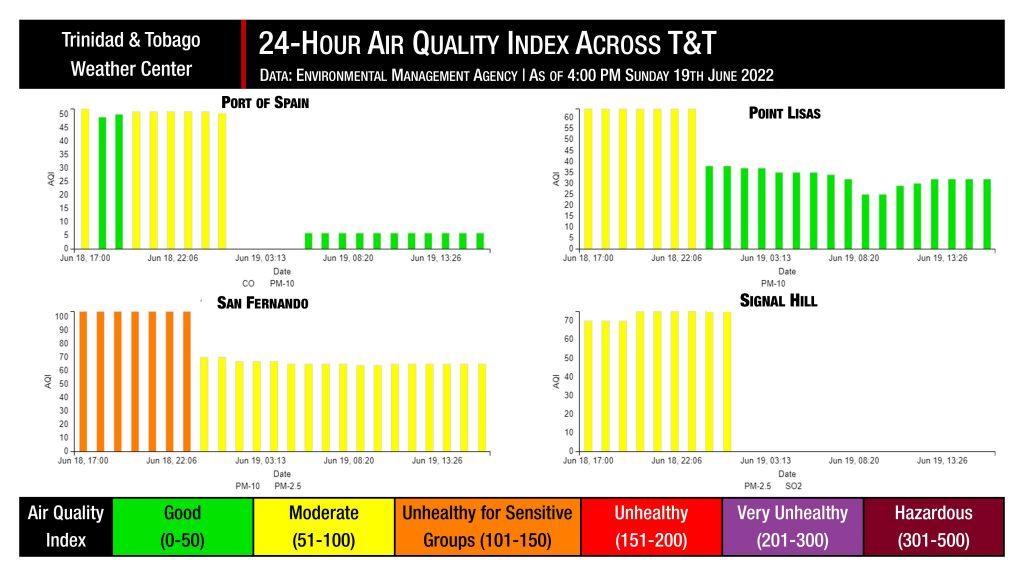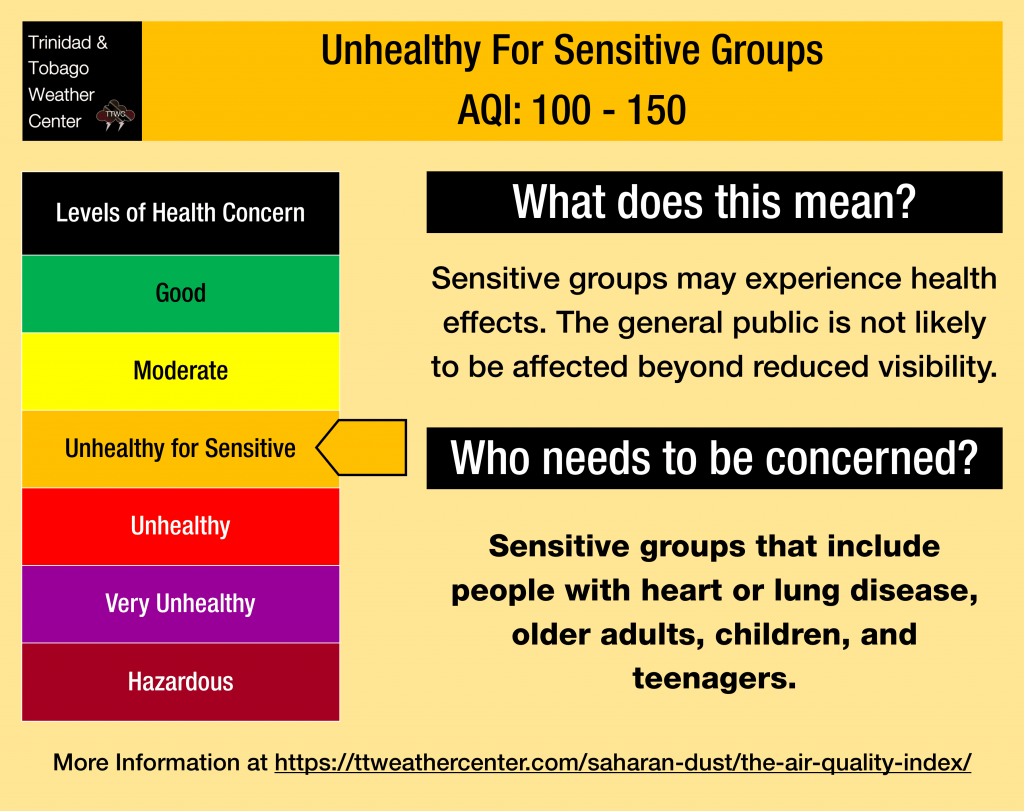While air quality and visibility are set to improve early Monday, by the overnight hours, a moderate to high concentration surge will arrive across T&T.
What you need to know
— Saharan Dust Surges: Elevated dust levels will linger through early Monday, June 20th, 2022. A new surge of dust is forecast to arrive by late Monday, June 20th, 2022 into Tuesday, June 21st, 2022 with fluctuating moderate to high concentrations lingering through the end of June 26th, 2022. Mild to moderate concentrations will linger across the region through the end of June 2022.
— Impacts: Air quality levels across Trinidad and Tobago will vary between good to unhealthy for sensitive groups through the forecast period.
— What Should You Do: Sensitive groups should continue taking the necessary precautions, while the general population would be able to continue activities with minimal Saharan Dust safety measures.
Current AQI Levels Across T&T

The Environmental Management Agency (EMA) air quality monitoring stations at San Fernando, Port of Spain, Point Lisas, and Signal Hill have all recorded moderate air quality levels over the last 24 hours, with levels dipping to unhealthy for sensitive groups at San Fernando on Saturday afternoon into the night.
These measurements are based on PM2.5 (particulates the size of 2.5 micrometers and smaller, usually associated with increases in Saharan Dust, vehicle exhaust, and smoke) and PM10 particulates.
Over the last 24 hours, visibility remained near ten kilometers at the Piarco International Airport and A.N.R. Robinson International Airport at Crown Point, Tobago.
Saharan Dust Forecast

Ongoing Surge: Through Sunday, June 19th, 2022
A high-concentration surge of Saharan Dust has been moving across the Lesser Antilles since late Wednesday, June 15th, 2022. Peak concentrations ended today, Friday, June 17th, 2022, with moderate to high concentrations lingering through late Sunday, June 19th, 2022. Dust levels will return to minimal over a brief window by early Monday into early Tuesday.
Air quality levels will vary between good to moderate, with the visibility near ten kilometers outside of shower or thunderstorm activity.
Surge #2: Early Tuesday, June 21st, 2022
Following Tropical Wave 10 on Monday, another surge of dust is forecast to move across the region. Moderate to high concentrations are forecast to linger through the end of June 26th, 2022. Mild to moderate concentrations will linger across the region through the end of June 2022.
Air quality levels will vary from good and unhealthy for sensitive groups, with the visibility dropping as low as six to eight kilometers outside of shower or thunderstorm activity.
What does this mean for you?


The air quality will be degraded through the forecast period. During high traffic periods, particularly between 6:00 AM and 9:00 AM, and again from 3:00 PM through 6:30 PM, air quality may be further reduced in localized areas.


Sensitive groups, such as children, the elderly, and persons who suffer from respiratory ailments and allergies, should avoid prolonged or heavy exertion and keep medication nearby.
According to the Trinidad and Tobago Meteorological Service, “the 2022 Saharan Dust Haze Season is likely to peak from June to August with the number of Saharan dust haze days expected to increase significantly. The duration of the plumes of Saharan dust haze visiting both islands is also likely to be more prolonged than earlier in the year, with increased odds for higher dust haze concentration during plumes visitation.”
We’re in a period where the Intertropical Convergence Zone and Tropical Waves may shield Trinidad and Tobago from the Saharan Dust events. While tropical waves play a notable role in moving dust across the Atlantic and the Eastern Caribbean, these periodic tropical waves also improve air quality.
The concentration of the dust that follows the wave depends on its strength as it moves off the West African Coast. This is because of stronger thunderstorms across Central Africa. As strong winds move downward and outward from these thunderstorms, the wind kicks up dust as it moves across parts of the Saharan Desert and transports it into the upper atmosphere. This “plume” of dust follows the axis of the wave as it progresses westward into the Atlantic.
Dust that makes it into the upper levels of the atmosphere can then get transported across the Atlantic Ocean. The plumes of dust eventually affect the Eastern Caribbean.
Larger, more concentrated plumes of Saharan dust begin to occur in April and continue through November.











